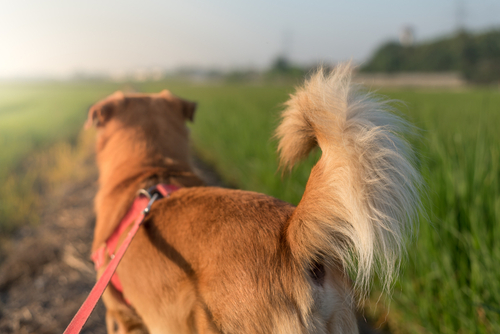July 24, 2025
Why Dogs Wag Their Tails — and What It Really Means
A wagging tail is one of the most recognizable and endearing traits of our canine companions. But have you ever wondered what your dog is really trying to say when their tail is happily — or not so happily — moving back and forth? Tail wagging is far more complex than it may seem, and understanding its meaning can help you deepen your bond with your furry friend and respond to their needs more effectively.
Whether the tail wagging is a joyful greeting or a sign of discomfort, knowing the reasons behind this behavior empowers you to be a more attentive and thoughtful dog owner. To that end, tools like Gladiator K-Nine’s collar can be invaluable in helping you interpret your dog’s cues while addressing their well-being.
Why Do Dogs Wag Their Tails?
Dogs use their tails as a key communication tool, much like humans use facial expressions or gestures. A wagging tail can convey emotions, intentions, and even physical discomfort. However, not all tail wags are created equal. The speed, direction, and position of the wag can give you vital clues about what your dog is experiencing.
Dogs wag their tails to communicate, often intensifying the motion in response to external stimuli. Here are the primary reasons behind this behavior:
1. Positive Reasons for Tail Wagging
There’s no mistaking the excitement we feel when our dogs greet us with their tails wagging exuberantly. These positive tail wags indicate happiness, affection, and enthusiasm:
- Excitement or Happiness: A quick, wide wag with the tail held at a medium height often signals pure happiness. For example, your dog might wag their tail like this when you come home or during playtime.
- Friendly Greetings: Dogs often wag their tails to show friendliness toward another animal or person. Paired with relaxed body language and soft eyes, this gesture often indicates a willingness to engage.
- Anticipation of Rewards: A tail wag as you reach for their leash or treat jar usually means your dog is thrilled about the upcoming activity.
- Confidence or Pride: When a dog’s tail is held high and wagging in sweeping movements, it’s often a sign of confidence and alertness, particularly when receiving praise or showing off an accomplishment.
2. Negative Reasons for Tail Wagging
While tail wagging is often positive, it’s important to recognize when it could indicate stress, discomfort, or even aggression:
- Anxiety or Nervousness: A lower, slower wag may point to unease or uncertainty. For example, in an unfamiliar environment, your dog might wag their tail cautiously while observing their surroundings.
- Submission or Fear: A tail tucked between the legs with very slight movement often suggests fear or submission. This wag is meant to signal avoidance or a lack of threat.
- Aggression or Defense: Interestingly, some aggressive or defensive dogs wag their tails as they prepare to confront a perceived threat. This wag is often stiff and deliberate, not relaxed or loose.
- Pain or Discomfort: Dogs may wag their tails in erratic or unusual patterns if they are in pain or experiencing physical discomfort, such as an injury, illness, or irritation.
Key Tail Movements to Watch For
Here are some common tail movements and what they typically mean:
- High and Wagging Broadly: Confidence, excitement, or happiness.
- Mid-Level and Wagging Softly: Friendly intentions or curiosity.
- Low and Tucked: Fear, submission, or distress.
- Stiff and Wagging Quickly: Alertness or defensive behavior.
- Circular Wagging (“Helicopter Tail”): Extreme joy or affection—usually reserved for very special moments, like greeting a favorite person.
Recognizing these subtle nuances can help you take proactive steps to address your dog’s needs—whether that’s providing reassurance or giving them time to regroup.
How the Gladiator K-Nine Collar™ Can Help
Understanding behavior is critical, but tools like the Gladiator K-Nine Collar™ can elevate your dog’s care by providing even deeper insights into their well-being. This advanced collar is designed to reduce your dog’s stress levels and physical health, making it easier for you to identify changes in their behavior, including unusual tail wagging patterns.
Acting on What Your Dog Tells You
Every tail wag is an opportunity to strengthen your connection with your dog. If your dog’s tail indicates stress, discomfort, or other issues, take time to assess their environment and physical health:
- Ensure they feel safe and secure.
- Remove potential stressors or threats.
- Address pain or discomfort with the help of a veterinarian.
Likewise, when your dog wags their tail out of happiness or excitement, match their enthusiasm by offering playtime, cuddles, or positive reinforcement to encourage those joyful moments.
Bringing It All Together
A wagging tail is like a window into your dog’s world — a way they communicate emotions, needs, and intentions. By paying close attention to their tail movements, you can better understand their feelings, whether they’re signaling happiness or discomfort.
The Gladiator K-Nine Collar™ is the perfect companion for any dog lover who wants to take their care to the next level. From tracking activity and health to providing actionable insights, this innovative tool ensures you’re always in tune with your furry friend.
When it comes to understanding your dog, every wag tells a story. With the right knowledge and tools, you can ensure those stories are filled with comfort, care, and joy for your loyal companion. Contact us today to learn more about our therapeutic collar.



